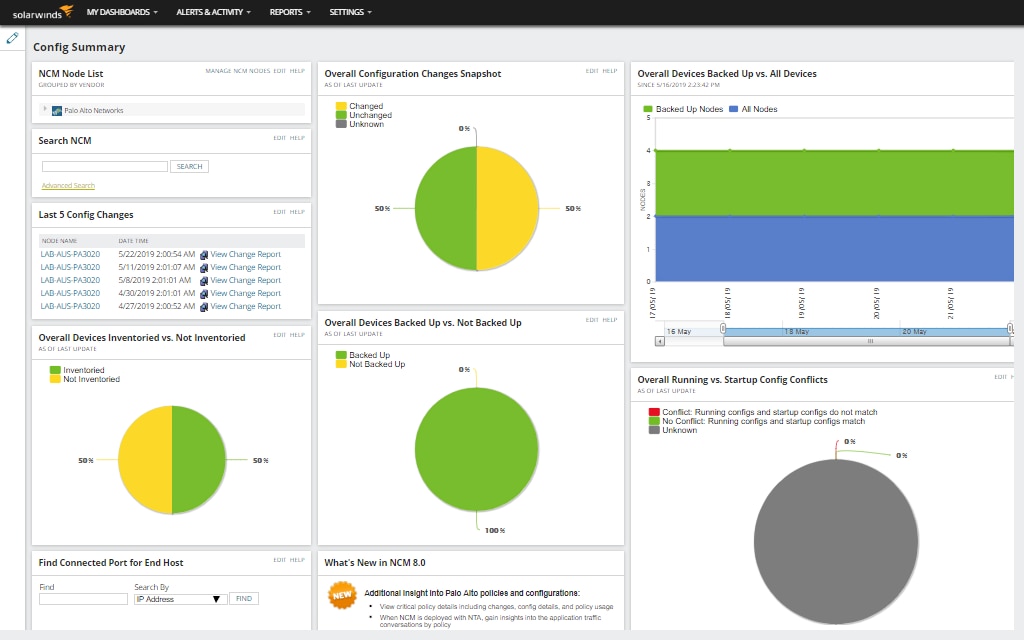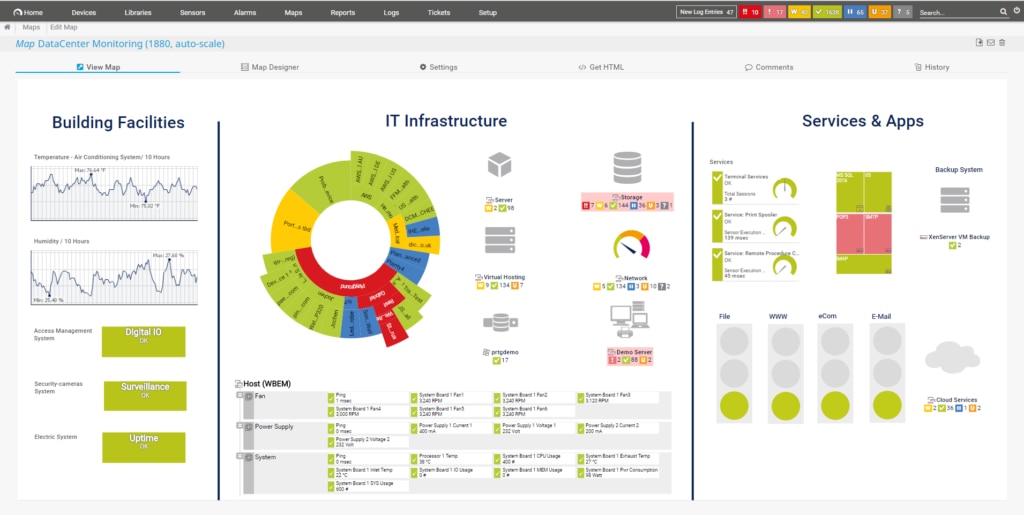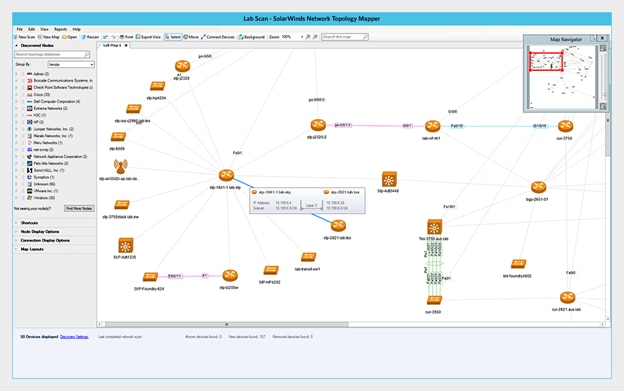Keeping your technology organized can be challenging. As you add new devices and phase out old ones, tracking each change can feel insurmountable. However, monitoring these updates is vital for most organizations, making the right network inventory tools indispensable.
Finding your best fit might be easier than you think. By understanding your network inventory management options, you can find the most effective software to support your unique IT infrastructure.
In this article, we’ll discuss why network inventory tools are such crucial investments. Then, we’ll walk through five of the most impressive network device inventory software options on the market. In my opinion, SolarWinds® Network Configuration Manager (NCM) and Network Topology Mapper (NTM) are the best options if you’re looking for network inventory tools.
5 of the Best Network Inventory Tools and Software Options
- Network Configuration Manager (NCM) (Free Trial)
- Network Topology Mapper (NTM) (Free Trial)
- Paessler PRTG
- Spiceworks
- Atera
What Is Network Inventory Management?
Simply put, network inventory management is the process of continuously discovering and maintaining a record of all the hardware and software that makes up an IT environment. This record should include key information about each of the assets that will make it easier to stay ahead of expiration dates and avoid overpaying for services you no longer use. While it is generally possible to handle network inventory management on your own in smaller organizations, as your organization expands — and as the number of hardware and software solutions that make up your IT environment grows — the process can become challenging without the help of network inventory software.
Network inventory solutions leverage SNMP to regularly scan and map your complete network, automatically updating the details on each device and service so you can access a list of all your assets in one place. It doesn’t matter if your devices come from different vendors, a network inventory system will combine them all into a single, intuitive list. That way your time and resources are freed up to work on more pressing issues with the knowledge that you always have an up-to-date network inventory available at your fingertips.
How Often Should I Do a Network Inventory Scan?
The answer to this question depends on how often your organization adds new assets or makes changes to your existing assets. Given that a network inventory system will typically let you schedule automated network scans as frequently or infrequently as you want, it’s a good idea to schedule scans to occur more often, even daily, rather than less often.
The biggest asset of a network inventory tool is that it takes the heavy lifting out of updating your inventory. The more regularly you perform scans, the more up-to-date your inventory will be. That means it’ll be easier to identify the services you are no longer using and to see details on all of your devices — even ones you only added recently.
Types of Network Devices Scanned and Identified by Inventory
When it comes to creating a thorough network inventory, you want to be sure that all of your network devices are scanned and identified no matter their vendor. Network inventory solutions, like those listed later in this article, can ensure your inventory is always current and includes all the newest additions to your IT environment.
Generally speaking, you want to inventory every piece of hardware and software in your IT environment as well as all the services you are paying for. The latter is particularly important given that, far too often, companies continue paying for services long after they stop needing them simply because they forget they have them.
As far as hardware network devices, your network inventory tool will scan and identify a wide range of assets including laptops, desktop computers, routers, printers, modems, mice and keyboards, mobile devices like cell phones and tablets, USB devices, and much more. For all of these, the tool will collect key information so you can access device details right from the inventory list.
Why You Need Network Inventory Tools
Network inventory tools are resources to help you keep track of all the assets in a technological ecosystem. They can help you understand which devices are present, which configurations they have, the statuses of any licenses, and so on.
It’s hard to overstate the importance of gathering and updating this information. IT networks are incredibly dynamic systems. Technology is constantly growing, upgrading, and becoming outdated—so it stands to reason your network inventory is, too.
These constant changes make it essential to keep an accurate record of your IT system’s current state. To detect and fix potential problems, you’ll need complete knowledge of all your network’s devices. For example, knowing the exact configuration of your technology can make change management easier.
A simple piece of network inventory software can be a formidable tool. However, not all these programs are of equal quality.
There are a few traits you might want to consider when selecting one, such as:
- A reliable network inventory scanner that will consistently gather new information when necessary
- A list of features that satisfy your organization’s needs within your price range
- An easily understandable interface to make analyzing data simple
In addition to these factors, there’s also something to be said for personal preference. We recommend you take advantage of free trials before you commit—a few weeks of consistent use might help find your best fit.
5 of the Best Network Inventory Tools and Software Options
Here are our top picks for the best network inventory software on the market today.
1. Network Configuration Manager (NCM) (Free Trial)

With this top-tier network configuration management system, you can stay on top of incoming data with intuitive graphs via a centralized dashboard.
One of NCM’s best features is its network inventory scanning. With this tool, you can automatically track and record all your devices across all your locations. The data collected includes serial numbers, IP addresses, and end-of-life information.
Getting that information is easy with NCM since all it takes is a few clicks to automate your network inventory scans and adjust your settings. You can schedule scans to occur as frequently or infrequently as you like with the freedom to always perform additional network scans in between scheduled ones. You can do those scans on the complete network or you can choose to focus on a single node for a faster scan of just the devices where there have been changes.
When it comes to scheduling scans, many advantages come with automating the network inventory process. Not only does it ensure you never forget to do a network scan, which can have costly results if you end up missing an expiration date as a result, it also saves you time, reduces your workload, and helps you manage your entire network better.
In addition to scheduling scans, NCM also makes it easy to adjust inventory settings to choose which information is gathered during the scans. That means you can specify exactly what information is collected and it also empowers you to adjust the duration of scans. After all, the more information that’s collected during each scan, the fewer devices your network inventory tool will be able to scan at once.
Here are a few other stand-out features:
- Support for specific devices such as Cisco, HP, and Huawei
- Regular network updates to prevent any surprise changes
- Network automated change management that reduces the need for manual device updates
If you want to see the most detailed, up-to-date information about your network, this tool might be your perfect fit. NCM can help you take complete control of your system with customizable inventory reports that operate on your schedule.
SolarWinds offers a fully functional 30-day free trial. Give it a try to see these features in action.
2. Network Topology Mapper (NTM) (Free Trial)
If you liked the sound of the first tool but prefer a more map-centric approach, your organization might benefit from SolarWinds Network Topology Mapper. This visually focused network mapping tool with inventory features can chart out your system using detailed organizational maps.
This process happens automatically, but you don’t have to be a passive participant: you’re free to edit and connect new devices manually. As such, you get a solid inventory base that you can perfect if need be.
SolarWinds Network Topology Mapper offers a few other features, such as:
- Scheduled network scans to optimize the automation process
- An easy exporting process that lets you share your data in multiple formats
- The ability to create new maps without having to conduct a new scan every time
If you’re a visual person, this software might be ideal for you. You still have access to the data in text format. Additionally, it translates into maps for a more straightforward analysis.
Additionally, SolarWinds Network Topology Mapper may be a wise choice if you’re looking for a hands-off solution. The automatic scanner is accurate and detailed, meaning you’ll only need to edit the data on rare occasions. This feature makes using the software an easy way to consistently create snapshots of your network architecture.
Like other SolarWinds products, you can take advantage of a free trial before investing.
3. Paessler PRTG

Paessler PRTG is another top-tier network management tool. Its most impressive feature is a dynamic logging system. Rather than scanning on a schedule, this software will detect whenever a change is made and update your reports to reflect it.
The intuitive, orderly dashboard complements this feature. You’ll see the updated results in real time. Best of all, it’s also customizable, so you can decide which metrics are shown and which are hidden.
In addition to this unique approach, Paessler PRTG also offers other features, including:
- Automatic alert options sent via SMS, email, or third-party applications like Slack
- A drag-and-drop interface to help you quickly compile your key reports on a single page
- A design that prioritizes an easy, user-friendly experience
We recommend trying Paessler PRTG if you’re not looking for anything besides accurate inventory monitoring. This network inventory software won’t help you complete concrete changes such as configuration management. However, if you don’t need it, this trade-off may be worth it.
The simplicity of this tool makes it a wise choice if you prefer the most streamlined experience possible. Paessler PRTG is a lightweight tool and excels in creating intuitive reports of your inventory, so you can work faster.
All PRTG plans come with free trials.
4. Spiceworks
You don’t necessarily need to spend money to get quality network device inventory software. If you’re looking for a basic, no-frills way to stay on top of your technology, then Spiceworks may be the tool for you.
This free option works almost entirely out of the box. There’s no need to compare pricing plans or set up complex settings: you can boot it up and get right to scanning your inventory. Moreover, it runs on a cloud-friendly system, making it easier to operate your cloud environment.
On top of these functions, the free Spiceworks software can provide you with other features such as:
- Detailed information such as storage capacity and whether a device is running antivirus software
- The ability to make an inventory of your help desk tickets
- Unlimited use on unlimited devices
If you’re running a small business with a tight budget, Spiceworks may be a good starting point.
However, you should probably be prepared for a lot of ads if you choose Spiceworks. Selling marketing space is how this company makes a profit. The ads won’t impact the tool’s power, but they might become annoying after a while.
Spiceworks plans are free for organizations of any size. There are no paid options.
5. Atera

Atera offers a network inventory multitool. It operates in two areas: Remote Monitoring and Management (RMM) and Professional Services Automation (PSA).
The network discovery capabilities come from the RMM module. It focuses not just on your devices’ metrics but also on their performance. For example, it can show you if your network is straining because of too many devices and highlight outdated ones you can remove to fix it.
In addition, there are other impressive features to consider with Atera, including:
- Service level agreement (SLA) tracking to help maintain your performance
- Cloud-based services that enable you to check in on your network from virtually anywhere
- Automated detection of potential upgrade opportunities for clients along with suggested pricing
We recommend Atera if you’re a managed service provider. It’s geared toward creating invoices for each device and clearly explaining the prices and processes to clients. The suggested upgrades feature can also help you take advantage of all financial opportunities.
Atera is priced per technician, per month, and there is a 30-day free trial available.
Conclusion
The right network inventory tools and software are essential for keeping your technical ecosystem organized. Fortunately, finding your best fit doesn’t have to be a challenge. By understanding the top options on the market today, you can make an informed decision about your network’s inventory management.
In this article, we covered five of the best network inventory software options:
- SolarWinds Network Configuration Manager offers a full-featured, hands-on approach.
- SolarWinds Network Topology Mapper provides a more visual approach to inventory analysis.
- Paessler PRTG offers a simple yet effective way to focus on inventory monitoring.
- Spiceworks is a free, no-frills option for those on a budget.
- Atera can suit tech professionals who work closely with their clients.

